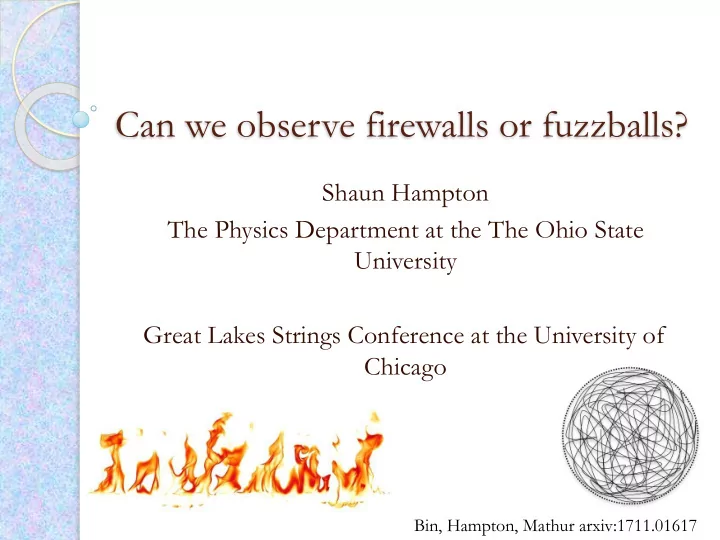

Can we observe firewalls or fuzzballs? Shaun Hampton The Physics Department at the The Ohio State University Great Lakes Strings Conference at the University of Chicago Bin, Hampton, Mathur arxiv:1711.01617
Firewall Argument Hawking Radiation – monotonic increase in Entropy (Hawking) Proposed by A lmheiri, M arolf, P olchinski, S ully in 2013 ◦ (1) The information of the hole is radiated away the same way as any other black body (no monotonic increase in entropy) ◦ (II) Consider a surface located at 𝑠 " (stretched horizon) which is 1 𝑚 & outside of horizon ( 𝑠 ' = 2𝐻𝑁 ) then for 𝑠 > 𝑠 " physics is described by Effective Field Theory
Issue with Firewall construction (I) and (II) are in conflict with each other ◦ (I) standard radiation, (II) 𝑠 > 𝑠 " EFT Why? Well consider a black hole of mass 𝑁 . Using (II) anything at 𝑠 > 𝑠 " should behave according to ‘normal physics’ Consider collapsing shell of massless particles of mass ∆𝑁 . The shell will collapse all the way down to 𝑠 = 𝑠 " uhindered . = 2𝐻(𝑁 + ∆𝑁) but by (II) it must Horizon at 𝑠 ' past ‘without problem’ through this region
Issue with Firewall construction Information gets trapped inside it’s own horizon Violates postulate (II): 𝑠 > 𝑠 " have EFT because we need nonlocal effects to recover information Energy can’t radiate from the surface violating (I) 𝑠 E ' . 9/; 𝑠 𝑡 343356 = 𝐹 ' 𝑚 & . 𝑈 𝑡 343356 1 𝑈 = 4𝜌𝑠 '
‘Modified firewall conjecture’ Consider particle of energy 𝐹 falling towards black hole of mass 𝑁 At a certain distance 𝑡 343356 from the horizon, 𝑠 ' , the particle should be swallowed up by a new horizon Quantum gravitational effects must arise at or before 𝑡 343356 ◦ Fuzzball construction (tunneling into new fuzzball states as particle approaches 𝑡 343356 ) (Mathur, Lunin, et al) ◦ Fuzzball radiates from its surface: consider interactions of in-falling particle with radiation at 𝑡 > 𝑡 343356 ◦ If 𝑄 ?@A ~1 ⇒ firewall, if 𝑄 ?@A ≪ 1 ⇒ NO firewall
Fuzzball Geometry Assume we have a fuzzball (long vibrating closed string) with no charge or rotation, roughly spherical in shape; outside of the fuzzball surface we have the metric 𝑒𝑠 ; 𝑒𝑡 ; = − 1 − 2𝐻𝑁 𝑒𝑢 ; + 𝑒𝑠 ; + 𝑠 ; 𝑒Ω ; ; 1 − 2𝐻𝑁 𝑠 𝑠 Fuzzball boundary at 𝑠 3 = 2𝐻𝑁 + 𝜗 where G 5 F 𝑠 𝜗~ HI ( tight fuzzball ) 3 Giving proper distance s~𝑚 & 𝑠 ' = 2𝐻𝑁
Near horizon scattering Perform particle scattering in near horizon region 𝑠 − 𝑠 ' ≪ 𝑠 ' ◦ In this region we assume radiation is isotropic Corresponds to a proper distance 9/; 𝑠 − 𝑠 ' 9/; 𝑡~𝑠 ' Consider local orthonormal frame (Schwarzschild frame) so that metric is locally flat 𝑠 3 . 𝑠 − 𝑠 ' ≪ 𝑠 '
Electron-Photon scattering 9/; 𝑡 343356 = 𝐹 Electron-photon scattering 𝑚 & 𝑈 𝐹 > 𝑈 ⟹ 𝑡 343356 > 𝑚 & 𝑠 3 Electron of energy 𝐹 , 𝑀 = 0 e - Near horizon region 𝑠 − 𝑠 ' ≪ 𝑠 ' ⟹ 𝑡 ≪ 𝑠 ' 𝑠 3 Local Electron of e - I Q~ energy 𝐹 " 𝐹 Thermal distribution of photons in near horizon region with local Q~ 9 temperature 𝑈 "
Interaction Probability for electron- photon scattering 𝐹 = 𝑛 𝑁 = 1 𝑁 ⨀ e γ P interact 2. × 10 - S bubble 1.5 × 10 - 1. × 10 - 5. × 10 - 20 ( l ) 10 12 10 16 10 20 10 10 Probability never reaches ~1 There is NO FIREWALL! Bin et. al.
Consider Scattering of low energy photon off of positron/electron gas 𝑡 343356 ≲ 𝑚 & (inside of fuzzball surface) 𝑠 3 Photon energy 𝐹~𝑈 Near horizon region 𝑠 9 Q~𝑛 at s~ Local electron/positron gas at threshold 𝑈 3 Y e - e + Q~𝑈 Q Local photon energy 𝐹 e - e + s~ 1 𝑛 9 9 ?@A ~𝛽 ; where 𝛽 = found that 𝑄 and 𝑄 6Y6Z[6@\6 ~ 9WX (YZ ] ) ⟹ 𝑄 3^\_"\^AA6Z = 𝑄 ?@A 𝑄 6Y6Z[6@\6 ≪ 1 𝑔𝑝𝑠 𝑁 = 𝑁 ⨀ ; 𝑄 Z6b56\A?c@ ≪ 1
Acknowledgements I would like to thank Samir Mathur, Bin Guo for their work on the paper I would also like to thank Hong Zhang, Stuart Raby, Naiyesh Afshordi, and Vitor Cardoso I would like to thank the organizers for allowing me to talk at this great conference
Recommend
More recommend